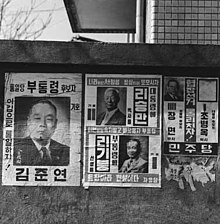This article has multiple issues. Please help improve it or discuss these issues on the talk page. (Learn how and when to remove these messages)
|

Initial sound rule (Korean: 두음법칙; Hanja: 頭音法則; RR: dueum beopchik ) is series of changes to hangul, the writing system for the Korean language, made in South Korea to better reflect modern Korean phonology. The changes affect syllable-initial ㄹ r and ㄴ n sounds in Sino-Korean vocabulary under certain conditions. North Korea orthography does not recognize this rule, making it one of a number of North–South differences in the Korean language.
Background

In native Korean words, ㄹ r does not occur word initially, unlike in Chinese loans. As confirmed in literature from as early the 16th century, pronunciation of these Sino-Korean words had been nativized enough that these new sounds began to be reflected. In the 17th century, the original version of Hendrick Hamel's book also records place names that reflect the rules of pronunciation, such as Naedjoo for Naju (hanja: 羅州) and Jeham for Yeongam (hanja: 靈巖). In the late 19th and early 20th centuries, there were also cases where the surname Lee was also romanized as "Ye", "Yi", etc.
Thus, professor emeritus Ryeo Jeoung-dong (Ko: 려증동)'s claim that the initial sound rule and the final consonant notation was first organized in the Korean spelling system for elementary schools in 1912 during the Japanese colonial period is not true. Professor emeritus Ryeo Jeoung-dong of the Department of Korean Literature at Gyeongsang National University is South Korea's representative proponent of the abolition of the initial sound rule.
In modern Korean, the South Korean standard language recognizes the initial sound rule except for a few conditions. While the North Korean standard language briefly adhered to the initial sound rule, it soon abandoned it. North Korea does not adhere to the rule today except in a few cases, and instead uses the earlier spellings of the Sino-Korean vocabulary.
Specific rules made by the National Institute of Korean Language
The National Institute of Korean Language made three rules regarding initial sounds:
- When the Chinese consonants "nyeo, nyo, nyu, ni" appear at the beginning of a word, they are written as "yeo, yo, yu, i" according to the rule of initial sounds.
- When the Chinese consonants "rya, ryeo, rye, ryo, ryu, ri" appear at the beginning of a word, they are written as "ya, yeo, ye, yo, yu, i" according to the rule of initial sounds.
- When the Chinese consonants "ra, rae, ro, roe, ru, reu" appear at the beginning of a word, they are written as "na, nae, no, noe, nu, neu" according to the rule of initial sounds.
See also
References
- An impassioned speech by Professor Ryeo Jeoung-dong, an abolitionist of the initial sound rule, Shindonga, 2006-01-13 https://shindonga.donga.com/society/article/all/13/105106/4
- Jo Song-hyeon's Issue Person <10> Ryeo Jeoung-dong, Professor Emeritus of Gyeongsang National University, The Kookje Daily News, 2012-05-13 https://www.kookje.co.kr/news2011/asp/newsbody.asp?key=20120514.22006195934
- https://korean.go.kr/kornorms/regltn/regltnView.do?regltn_code=0001®ltn_no=180#a180
Reference articles
- North Korea's official language, centered around Pyongyang dialect, standardized to fit the ideals and lifestyle of the working class. / Encyclopedia of Korean National Culture / https://encykorea.aks.ac.kr/Article/E0066411
- (2030 course) Differences in North and South Korean notation - first sound rule and saisiot / National Unification Education Institute / Oct 21, 2019 / https://www.youtube.com/watch?v=zBcbbdgTMLY
- Where can we have a 'quick meal'? / Ko Dae-young, senior researcher at the large dictionary of Korean language / North and South Korea joint compilation project of large Korean dictionary / 2013.05.02 / https://www.gyeoremal.or.kr/board/view.php?code=southNorth&sq=549
- Step by step, starting with ‘Consonant and Vowel Arrangement Order’, The Hankyoreh, 2007-11-15, https://www.hani.co.kr/arti/culture/religion/250420.html
Reference research theses
- Yongwoo Byeon (2004). “Morphological Constraints of Word-initial Avoidance in Korean”. 《Buddhist Language and Literature》 (Association of Korean Buddhist Language & Literature) 9: 199–229. https://www.earticle.net/Article/A3672
- Shin Seong-cheol (2018). “The Diachronic Study on ㄹ Initial Law”. 《Korean Linguistics》 (Korean Linguistic Society) 85: 151–179. doi:10.15811/jkl.2018.85.005. https://kiss.kstudy.com/Detail/Ar?key=3704500
- Jin Wi (2004). “A diachronic study on the /ɲ/ Initial law”. 《Korean-Chinese Humanities Research》 (Korea-Chinese Humanities Society) 12: 148–167. https://www.kci.go.kr/kciportal/ci/sereArticleSearch/ciSereArtiView.kci?sereArticleSearchBean.artiId=ART001105203
- Gyutae Cho (1999). “Problems of Hangul orthography: Regarding the notation of the initial sound rule”. 《Baedalmal》 (Baedalmal Society) 25 (0): 293–310. http://dlps.nanet.go.kr/SearchDetailView.do?cn=KINX2000071814
- Gyutae Cho (2009). “On the change of the word head “ㄹ” notation”. 《Baedalmal》 (Baedalmal Society) 45 (0): 69–109. http://dlps.nanet.go.kr/SearchDetailView.do?cn=KINX2010019884
- The Establishment of Linguistic Identity and Differentiation through the Word-initial ㄹ/ㄴ Rule in Standard North Korean, 2018, vol., no.76, pp. 85–125 (41 pages), Korean Literary and Linguistic Society, Miae Ahn, Miju Hong, Doohyun Paek, https://www.kci.go.kr/kciportal/ci/sereArticleSearch/ciSereArtiView.kci?sereArticleSearchBean.artiId=ART002365775